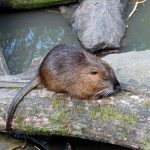Large, semiaquatic rodents belonging to the genus Castor, beavers are endemic to the temperate regions of the Northern Hemisphere. Both the North American beaver (Castor canadensis) and the Eurasian beaver (Castor sibiricus) are considered living species (C. fiber). The capybara is the world’s largest live rodent, although the beaver is the second-largest. They have stocky bodies with huge heads, long incisors that resemble chisels, fur that is brown or grey, front feet that look like hands, hind feet that are webbed, and flat, scaly tails.
The Eurasian beaver has a lighter fur color, a narrower tail, and a more elongated cranium than its North American counterpart does. Additionally, its nasal bone hole is triangular. These creatures are known to inhabit a variety of freshwater settings, including rivers, streams, lakes, and ponds, among others. They eat plant matter, such as tree bark, aquatic plants, grasses, and sedges. They are herbivores.
The beaver uses tree branches, plants, boulders, and mud to construct its lodges and dams; it also chews down trees to use as a source of building material. Dams hold water back, and people take refuge in lodges. Due to the fact that they are responsible for the formation of wetlands, which are then utilized by a great number of other species, and because of the influence that they have on the other organisms that make up the ecosystem, they are referred to as keystone species.

There are different ways to stop beavers from building dams. Some of these are given below:
- Knowing What’s Legal
If you live in Oregon, Washington State, or Canada, the beaver is a symbol of regional or national pride because it is a nice, kind animal that does a lot of good work for the environment. Beavers are also a symbol of regional or national pride in the United States. It is not only illegal to shoot a beaver in the majority of states and situations, but it is also not recommended to do so.
There is a wide variety of wildlife control organizations that can assist you in removing them in a way that is both secure and kind. Beavers are most successful in habitats that provide them with both access to water and the materials necessary to construct dams out of wood. If you remove either one or both of these requirements (at least temporarily), there is a good chance that the beavers will leave on their own accord.

- Sprays and Repellents
This is one of the methods that have the highest rate of success but also has the highest rate of failure. Because they are wild animals, beavers have a natural olfactory sense that is both drawn to and repelled by a variety of odors. The best way to get beavers to leave an area is to spray it with something that does not “smell good” to them. Beavers are very sensitive to odors. In spite of this, it is possible for certain sprays to be harmful to beavers, just as insecticides are made to kill insects. Because you most certainly do not want to cause the beavers any harm, you will need to exercise an excessive amount of caution whenever you use this technique.
- In addition to this, there is no assurance that you won’t turn up your nose at the area that you have just sprayed with an anti-beaver spray yourself. This is not something that can be guaranteed.
- It’s possible that removing beavers from your backyard or the area close to your house is necessary in order to preserve the land there, but if it smells bad, are you going to want to spend time there?
- Aside from that, sprays lose their effectiveness over time, at which point the beavers may return.
- Sprays, assuming you don’t mind the smell of them, may therefore be a short-term solution for preventing beavers from building dams. However, sprays are just one piece of a larger puzzle that involves dislodging dams and driving out beavers.
- Building a Fence Around Water Sources
You can stop beavers from building dams by simply cutting off access to the water supply in the area where they build dams; this is, in essence, damming the site on your own terms. Of course, humans have a different understanding of water engineering and irrigation than beavers do. As a result, you can still wall off the site to beavers while still building pipes or other ways for the water to flow beneath, allowing it to reach where it needs to be. The Beavers are unable to do this.

- Trunk Guards
The fundamental reasoning behind this overarching strategy is obvious. Beavers will move to a new location if they are unable to obtain the necessary amount of wood for building their dams because beavers are known to do this. Building galvanized welded wire fences to a height of approximately three feet is one simple way to accomplish this goal. This should be low enough for you to easily access the rest of the tree while at the same time being high enough to prevent beavers from climbing the fence and preventing them from doing so. Galvanized steel and fences that are made from it are common, which is one of the advantages of going with this particular alternative. These can be a good, common, and inexpensive alternative if you can’t find the specialized meshes that are needed for the solutions for tunnels and holes described above.
- A Sandy Solution
Sand should be used to cover the base of the tree, the tree trunk, and any other areas that beavers might chew on. This should be done up and down the tree trunk. Because beavers, like most other animals, find the taste of sand in their mouths unpleasant (after all, who does?), this tactic proves to be an especially effective deterrent. Brush the targeted area with a mixture consisting of about 8 ounces of sand and one quart of paint. This will produce the best results. It is important to keep in mind that trees that are less than six feet tall can be more sensitive than their fully-grown counterparts can. Because of this, you should avoid taking this action with younger trees because it can cause damage that will last for a long time.
Is there a repellent for beavers?
Ineffective beaver repellents are currently on the market, which makes it difficult to keep these animals at bay. However, if you avoid certain plants within the landscape and clear the area around ponds and other bodies of water of shrubs and trees, you should be able to discourage these animals from inhabiting your yard. Beavers can be repelled with a wide variety of products, but most exterminators who specialize in pest control agree that these products are not as effective as their manufacturers claim they are.

There are two main categories of these repellents
- scent aversion repellents
- predator urine scents
- Scent aversion repellents
Scent aversion repellents include things like ammonia, mothballs, garlic, and other similar substances. It is possible to protect trees by painting the bark of trees with a mixture of alkyd paint and coarse sand at a rate of 4 ounces of mason sand per quart of paint, but the results have not been consistent. Beavers may not be able to establish a breeding population in an area if castor is used on the mounds. Be aware that in order for the castor to be effective, it must first be applied to the area and then maintained before the beavers arrive at the location.
- Predator urine scents
The presence of wolf urine on overland trails may encourage beavers to look for food in other areas. The presence of putrefying eggs, blood products, and hydrolyzed casein in repellents has caused beavers to avoid plants that have been treated with them.
What are beavers afraid of?
Some people have tried to scare the beavers away from their property by using scare tactics such as tearing down the dam that the beavers built on their pond or chasing the beavers out of their yard. However, the effectiveness of these strategies has only been demonstrated for brief periods, ranging from a few days to a week. Beavers are resilient animals. You will need to look into other ways to get rid of them because there is no reliable way to permanently frighten them away from your property.
Can Beavers Float and Swim Like Hippos?
Can Beavers Float and Swim Like Hippos? Hippos, despite their massive size, are built for aquatic life. They possess dense bones that prevent them from sinking and a layer of fat that assists with buoyancy. On the other hand, while beavers are proficient swimmers, they lack the specific adaptations of hippos. Nevertheless, beavers are skilled at constructing dams and lodges, utilizing their webbed feet and paddle-like tails to navigate through water. Hippos drowning and floating explained.
How to get beavers to move?
The beaver consumes only twigs and various kinds of herbaceous plants due to its vegetarian diet. One of their primary sources of nutrition is the bark of trees, with cottonwood and willow trees being some of their absolute favorites. In addition to maple and poplar trees, aspen, birch, and alder are high on their list of preferred tree species. Therefore, if all of these trees are taken down, the number of beavers on the property could go down by a lot.











